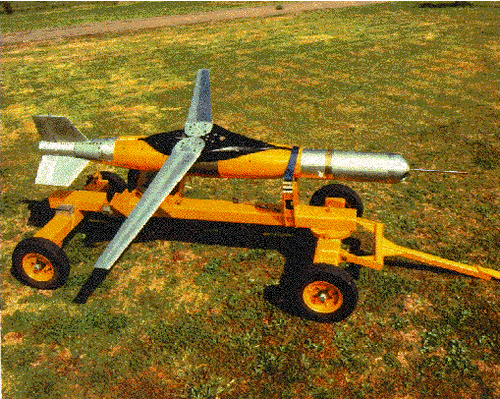- Joined
- 9 October 2009
- Messages
- 21,976
- Reaction score
- 13,636
Does anyone have any pictures or other detailed information on this program?
Kerkanya
In the late 1970s, an idea arose at the Defence Research Centre, Salisbury, for a glide bomb that would use an energy management algorithm to maximise its glide range. In 1977, the RAAF placed a research request with DSTO, resulting in the General Test Vehicle (GTV) program, which eventually become known as Kerkanya.
Kerkanya was essentially a set of glider wings and a tail control system which could be strapped on to “dumb” bombs, enormously increasing their range and accuracy. When dropped from an aircraft at high altitude and sub-sonic speed, the folding wings deployed and three servo-controlled tail fins guided the vehicle along a pre-programmed flight path under control of the digital auto-pilot processor.
With a range of more than 100 kilometres, the vehicle was manoeuvrable enough in flight to attack moving surface targets such as ships. Another advantage was that if an infrared seeker, or other terminal guidance system was added, the vehicle would become a sophisticated weapon at a fraction of the cost of conventional “stand-off” weapons.
Development of Kerkanya continued through the late 1980s and early 1990s with a successful series of flight tests being carried out at Woomera in 1988 and 1989. These tests clearly demonstrated that the vehicle could outperform existing and planned glide bombs in the US and NATO inventory.
In 1991, a 1/8th scale model of Kerkanya was employed in wind tunnel tests to examine the performance and stability characteristics of Kerkanya and to provide data for simulation and flight control system development. However, a planned series of Kerkanya trials never eventuated because of funding cuts.
In 1995, AWA Defence Industries (later taken over by BaeA) signed an exclusive agreement with DSTO to assess the world-wide market potential for the technology. Soon thereafter, AWADI acquired the rights to commercialise the technology of the DSTO glide bomb design.
DSTO website
Boeing has tapped Ferra Engineering to manufacture extended range wing kits for the Joint Direct Attack Munitions (JDAM) carried by Royal Australian Air Force F/A-18 A/B Hornet fighters.
The contract award was disclosed by Australia's minister for defence materiel Mike Kelly, who welcomed Boeing's selection of Brisbane-based Ferra.
"The wing kit will almost triple the weapon's current range, making the JDAM-ER a very cost-effective weapon," says Kelly. "The wing kit is based on the 'Kerkanya' glide technology initially developed by Australia's Defence Science and Technology Organisation (DSTO)."
"Kerkanya" was a DSTO programme in the 1980s to research glide bomb technologies.
In August 2012, Boeing announced that a winged version of the JDAM had completed windtunnel tests. The JDAM-ER features a "modular, add-on wing kit", developed in Australia, that can triple the 226kg (500lb) weapon's glide range to over 64km (35nm), Boeing said.
The first wing kits will be used for flight tests in late 2013, with initial production orders likely to be completed by 2015. Canberra foresees an opportunity to sell the wing kit internationally.
LINK
Extended range for Joint Direct Attack Munition
DSTO, in conjunction with Hawker de Havilland
of The Boeing Company, recently conducted
successful initial testing of a smart bomb known
as the Joint Direct Attack Munition Extended
Range (JDAM-ER).
The JDAM-ER is a guided gliding bomb based
on the Mk 82 500lb General Purpose munition,
fitted with the Boeing GBU-38 JDAM global
positioning system-aided tail kit. It also has a
wing kit developed by Hawker de Havilland,
using the Kerkanya gliding bomb technology
developed by DSTO in the 1980s.
The tests were conducted at Woomera,
South Australia, in mid August this year, to
demonstrate the range and accuracy capabilities
of the new JDAM-ER when deployed with the
F/A-18 aircraft.
The development activity was conducted under
the Capability & Technology Demonstrator (CTD)
Program managed by DSTO. The trial proved that
major range enhancements can be provided to
existing JDAM Global Positioning System (GPS)
Guided Bombs.
Consideration will now be given to further
develop the wing kits to bring them to
commercial production. If the wing kits prove
to be commercially viable, there is likely to
be significant Australian industry input in the
required manufacturing activities.
Australian DefenceScience. Volume 14, Number 2 [2006]

